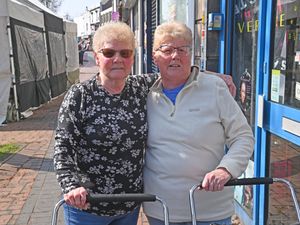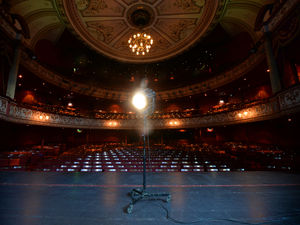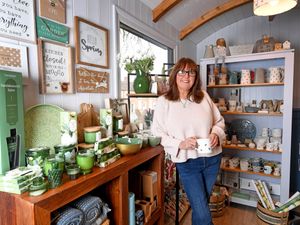Travel Review: Brazilian hideaway with a host of riches
Seeking shelter from a tropical rain shower, I hunker beneath a sprawling jucara palm. Although it provides refuge for up to 62 species, today its fronds do little to shield me from the heavy drops.
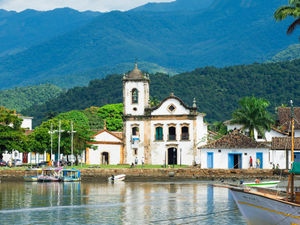
But the native Brazilian tree champions in many other ways, biologist and guide Samiris Freire assures me on a walk through an agroforest in south-west Brazil. Unlike single stem palms, its edible inner core can be harvested multiple times, while its purple fruits are packed with more antioxidants than superfood acai.
Now appreciation of Brazil’s natural riches is extending beyond the Amazon rainforest to focus on neighbouring biomes.
In 2019, the regions of Paraty and Ilha Grande, set midway between major cities Rio and Sao Paulo, were awarded Unesco status for their culture and biodiversity.
A 20-minute drive inland from Paraty, former 17th century sugar cane plantation Fazenda Bananal is one of several ecotourism projects aiming to open visitors’ eyes to the area’s beauty and educate about protecting it for generations.
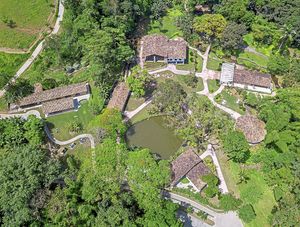
A large portion of the 180-hectare farm, purchased and restored by billionaire Jose Roberto Marinho, vice president of the Globo media group and an active philanthropist, is dedicated to agroforestry – the trending practice of bridging a gap between agriculture and forestry by cultivating vegetables, fruits and trees.
In contrast to the threat of soya bean monoculture that’s responsible for destroying vast swathes of Brazil’s natural habitat, it champions biodiversity, preserves forests, and provides a more affordable food source for communities.
Walking along a short trail curving around the back of the property, I crane my head to see dozens of bromeliads trailing from treetops. On several occasions I catch glimpses of the Brazilian tanager as his vermilion breast feathers flash like sparks from a fire in the deep, dark canopy.
Later, I’m shown camera trap footage of crab-eating foxes, agoutis, lesser anteaters and even the rare jaguarundi – an elusive, slender wild cat native to the Americas.
As Samaris rightly points out: “It’s just like the sea – there’s still so much unknown.”
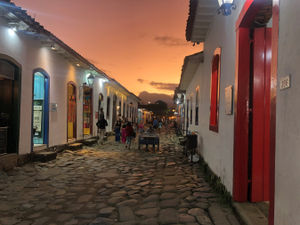
Ironically, the sea has always played an important role in this region. Originally inhabited by indigenous Guaianas Indians, Paraty (meaning ‘river of fish’ in the local language) was commandeered by Portuguese explorers in 1597. It rose to prominence almost 100 years later, after becoming a pivotal point in the Rota do Ouro, transporting gold from Minas Gerais and shipping it to Rio and onward to Europe.
Red pillars marking the route still line corkscrew mountain roads into the museum piece port town, where – despite a tumultuous past of rising and falling fortunes, with sugar, coffee and slaves subsequently traded – many of the original pastel-hued stone buildings still exist.
Another throwback from the past is the town’s intentional flooding. When I arrive at 5pm, a high tide has transformed Paraty into a mini Venice. Ornate metal pineapples decorating façades are reflected alongside towering palms in glassy pools.
Buildings were constructed slightly lower than sea level, with concave streets to allow water to flow in and sanitise the town, explains local guide Priscila Albernaz Maciel from Paraty Tours. Quite literally, it was a mega means of flushing the toilet.
Although the history of Portuguese presence is well documented, it’s much harder to find evidence of the indigenous and African communities who played an important – and tragic – role in Paraty’s past.
But as the sun disappears, leaving a whisper of mountain folds on the horizon, the town transforms into an outdoor art fair, with local artisans from a nearby quilombo – a community from the African diaspora – selling woven baskets. Their wares are a window into a culture tourists too often inadvertently overlook.
Once a centre of trade and commerce, Paraty now nurtures more creative talents.
In the 1970s, film stars, artists and musicians rediscovered the town, converting buildings into cafes, restaurants, bars and boutique hotels. But a wealthier set, who have moved in more recently, hole up in private homes around the bay.
Strolling past heaving party vessels moored up along the jetty, I step aboard Latitude, a former fishing boat skippered by sailing veteran Andre Soares.

During our five-hour day trip along the coastline of the Serra da Bocaina National Park, I explore secret bays backed by mountains smothered with broccoli florets of jungle, and weave through islands owned by Brazil’s ever-increasing number of billionaires.
At Jurumirim, I swim through jade-green waters, watching turtles surface for air in the mangroves, and rest on an empty beach strewn with pink hibiscus flowers. On hilltops above me, where crumbling forts once defended the coastline from invading, gold-hungry pirates, several well-preened gentlemen are playing golf.
Before heading back to town, we drop anchor outside a private island, where a wealthy philanthropist has been granted a government licence to breed a population of highly endangered golden lion tamarin monkeys. As frigate birds soar like arrows overhead, the palm-sized, ginger-maned creatures, which once widely roamed the Atlantic Forest, scamper into view.
Where to stay
Located in the historic centre of Paraty, restored boutique hotel Pousada Literaria has a million stories to tell – many stored in the pages of books displayed in every room. The official host for the city’s annual literary festival (usually held in July), the 25-room property is owned by Jose Roberto Marinho, also responsible for Fazenda Bananal.
Cheeses from the farm are served at breakfast, either around the heated pool or in the library. Stick around for dinner at the Quintal das Letras restaurant, serving a high-end farm-to-table menu.
An excellent base for exploring the town, the hotel can also arrange boat trips to the national park. Visit pousadaliteraria.com.br



